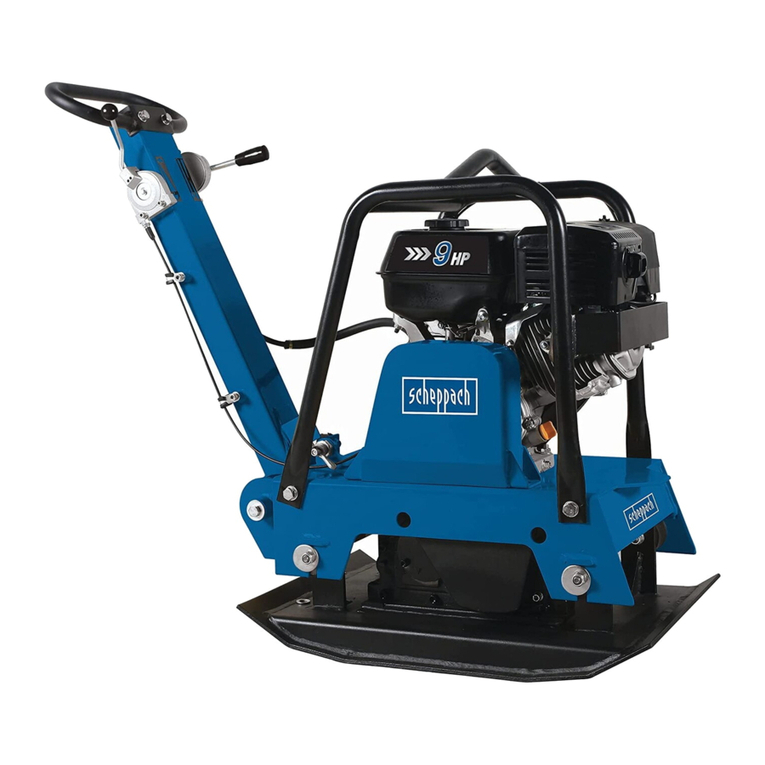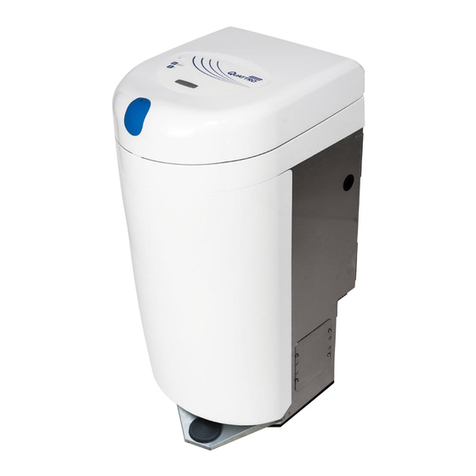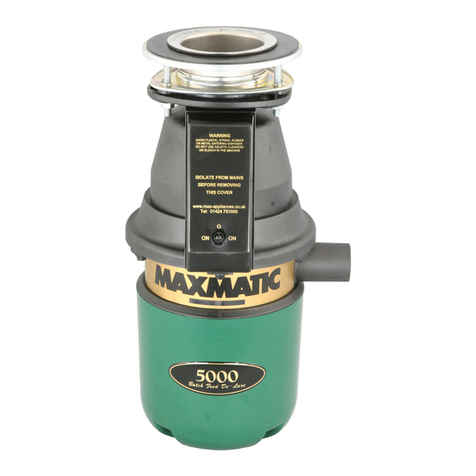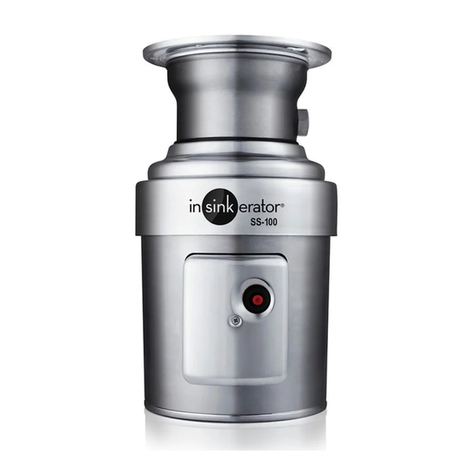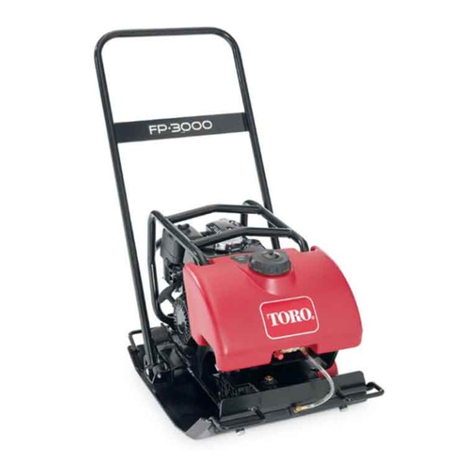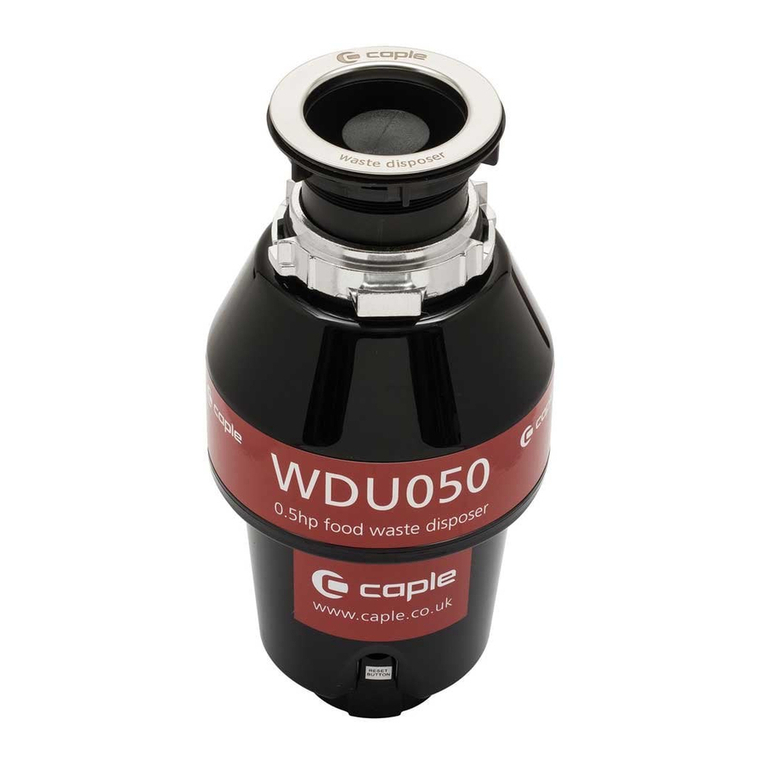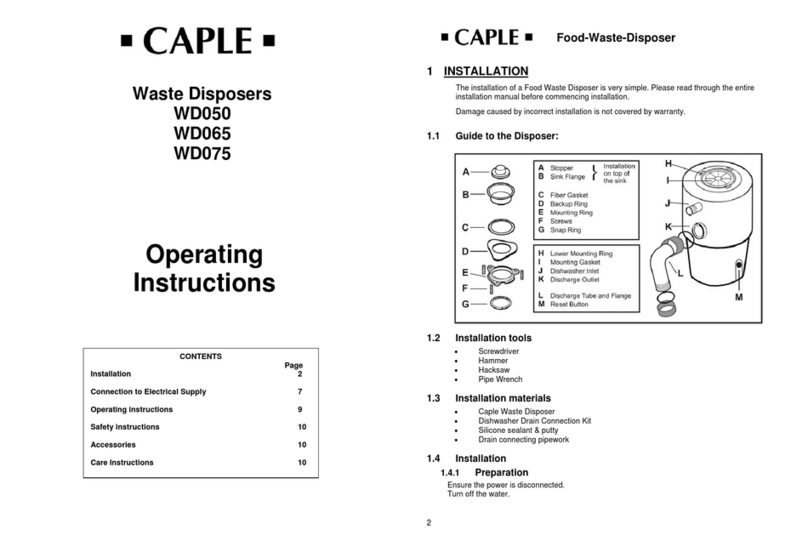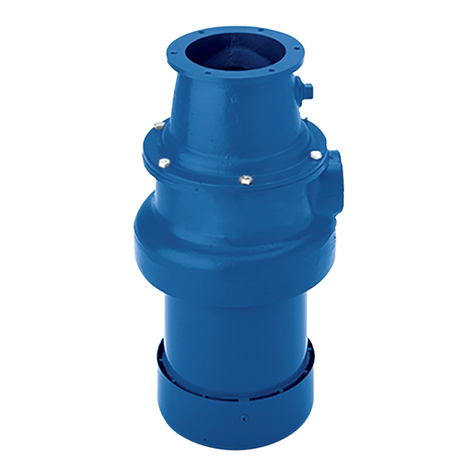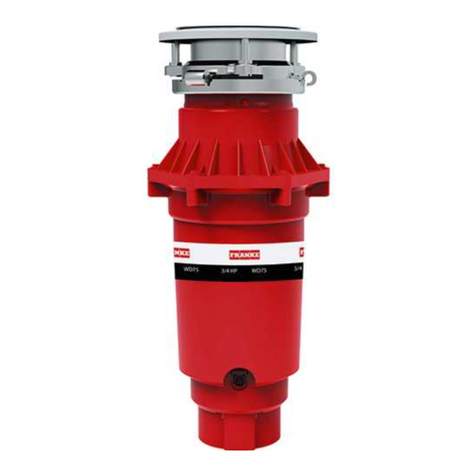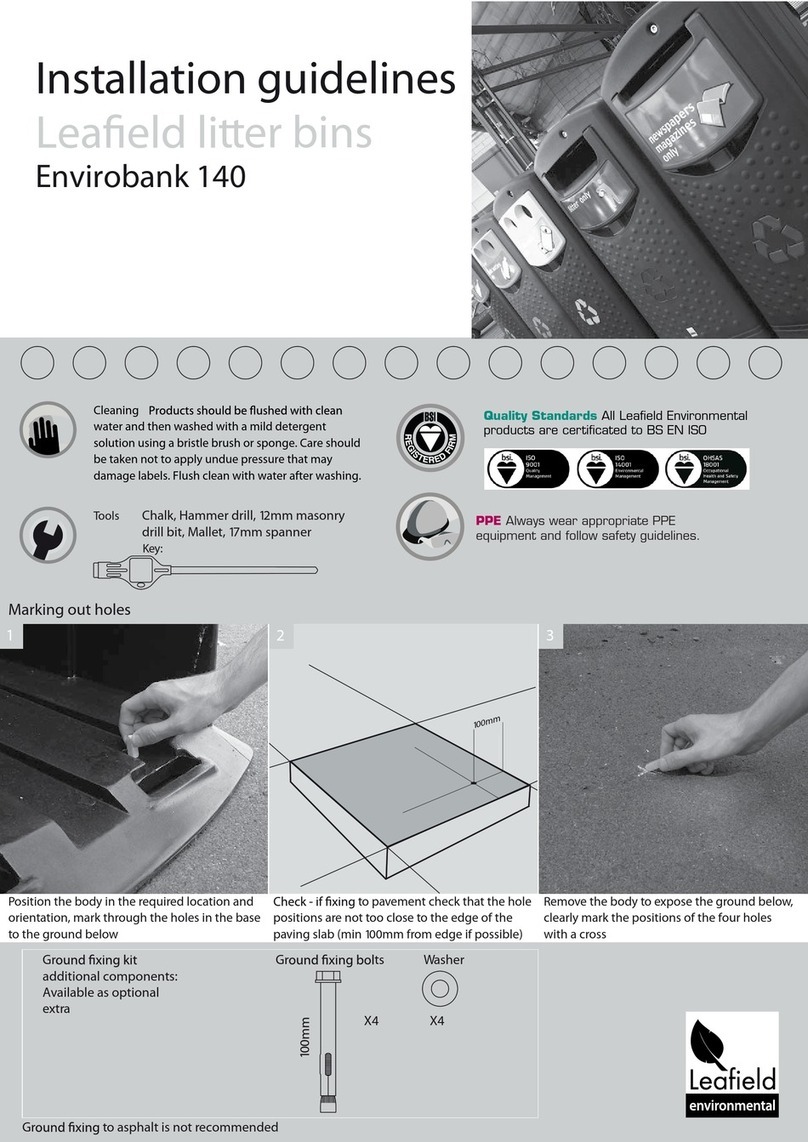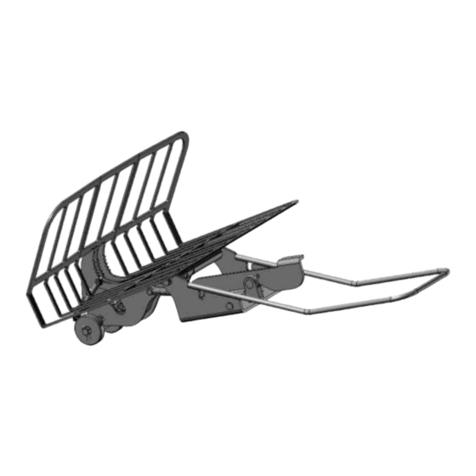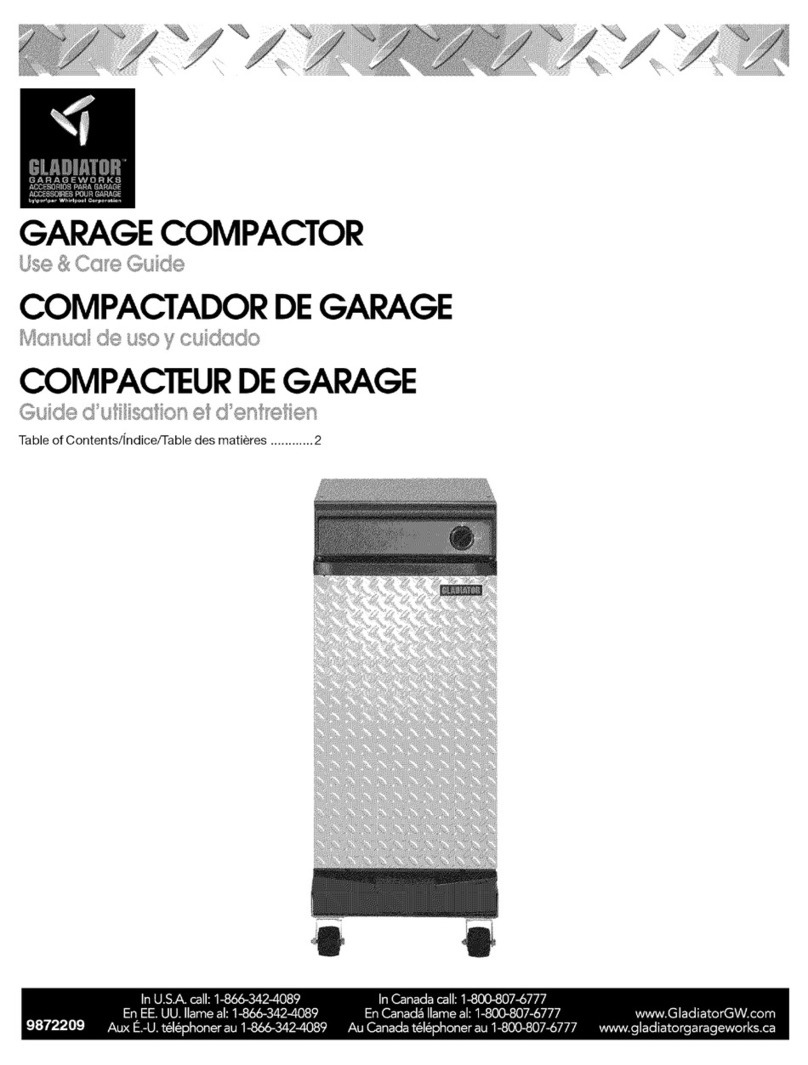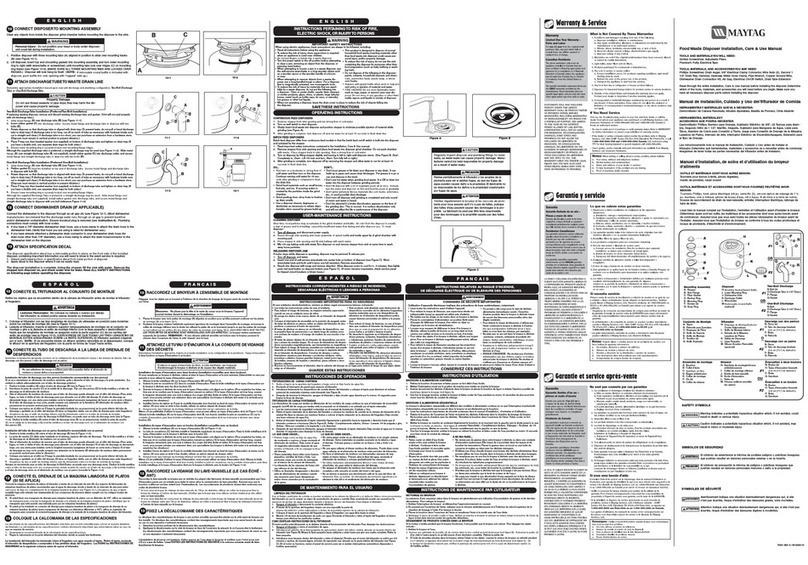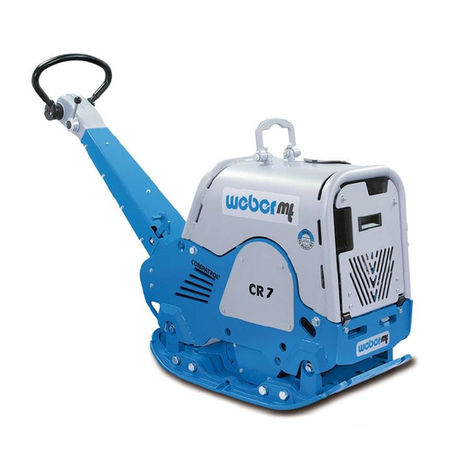
Instruction manual WDU050, WDU075 & WDU100 Instruction manual WDU050, WDU075 & WDU10014 15
Please keep this instruction manual for future reference Please keep this instruction manual for future reference
6
NNOOTTEE:: Pay close attention to the order of the sink flange
parts, as they have been correctly assembled by the
factory.
A. Disassemble the sink flange assembly from the
disposer by turn ing the mount ring to the left (clockwise)
and removing it.
B. Rais e the mount ring toward the top of the sink flange.
Remove the cushion mount and the mount ring. You may
want to practice installing the cushion mount at this point
before you are under the sink.
C. Unscrew the support ring from the sink flange and
remove the fiber gasket. You are now left with the sink
flange and the rubber gasket.
DD..TThheerruubbbbeerrggaasskkeettiissuusseeddiinnsstteeaaddooffpplluummbbeerrss
ppuuttttyywwiitthhssttaaiinnlleesssssstteeeellssiinnkkss..SSoommeecceerraammiicc ssiinnkksswwiillll
rreeqquuiirreeppuuttttyy oorr ssiilliiccoonnee..
E. If no putty is used, insert the sink flange through the
rubber gasket into the sink opening. Do not turn the
flange once it is seated.
F. If you use putty instead of the gasket, form a ring
around the underside of the sink flange. Insert the flange
into the sink opening, press down hard to squeeze out
excess putty. From under the sink, trim off excess putty
flush with the bottom edge of the sink opening.
G.From underneath the sink, slip the fiber gasket onto
the exposed sink flange. With arrows pointing up, screw
the support ring onto the sink
flange and hand tighten until
the sink flange will not move.
(NNOOTTEE: If your sink is more than
15mm thick you will need to flip
the supporting ring so the arrows
are pointing down. This will provide a greater distance on
the sink flange allowing it to be used on sinks up to
approximately 22mm thick). At this point you may want to
insert the stopper into the sink and fill with water to
HH
a
n
d
-
t
i
g
h
t
e
n
s
i
n
k
f
l
a
n
g
gee
check the sink flange seal and ensure there are no leaks.
H.Place the mo unt ring over the sink flange and hold in
place while installing the cushion mount (large side
down). Make sure the groove on the inside of the cushion
mount fits over the lip on the
sink flange, similar to putting
the lid on a plastic container
Run your fingers around the entire
the mount ring can be pulled downward over the
cushion mount and will be Groove Top
free to t urn.
Components
SSiinnkkffllaannggee
aasssseemmbbllyy
Stopper
Removable
splash guard
Sink flange
Rubber sink
flangegasket
Sink
Fiber gasket
support ring
Note arrows
indicating up
(
)
Mount ring
Cushion mount
(note TOP mark))
Elbow fange
screw
Discharge
elbow
Elbow gasket
base (end bell) Rating Label in This Area
(Electrical Connections)
Hopper
Rubbergasket
Correctly Installed Sink Flange
Sink flange
Fiber gasket
Sink flange
Sink
Support ring
Mounting ring
should be free
to move up and down
Groove
Cushion mount
IInnssttaallllaattiioonnIInnssttrruuccttiioonnss
1 CCoommppoonneennttss aanndd iinnssttaallllaattiioonn
Disposer
Tightening
Ears
Dishwash discharge inlet
IInnttaallllaattiioonn ooff tthhee ssiinnkk ffllaannggee
Bottom bead of
cushion mount
Open area
No obstruction
Bottom bead
(Shown for proper orientation)
cushion mount with slight
pressure. Do not press too
hard. When the cushion
mount is properly seate d,
CCuusshhiioonnmmoouunnttddeettaaiill
Bottom bead
6
NNOOTTEE:: Pay close attention to the order of the sink flange
parts, as they have been correctly assembled by the
factory.
A. Disassemble the sink flange assembly from the
disposer by turn ing the mount ring to the left (clockwise)
and removing it.
B. Rais e the mount ring toward the top of the sink flange.
Remove the cushion mount and the mount ring. You may
want to practice installing the cushion mount at this point
before you are under the sink.
C. Unscrew the support ring from the sink flange and
remove the fiber gasket. You are now left with the sink
flange and the rubber gasket.
DD..TThheerruubbbbeerrggaasskkeettiissuusseeddiinnsstteeaaddooffpplluummbbeerrss
ppuuttttyywwiitthhssttaaiinnlleesssssstteeeellssiinnkkss..SSoommeecceerraammiicc ssiinnkksswwiillll
rreeqquuiirreeppuuttttyy oorr ssiilliiccoonnee..
E. If no putty is used, insert the sink flange through the
rubber gasket into the sink opening. Do not turn the
flange once it is seated.
F. If you use putty instead of the gasket, form a ring
around the underside of the sink flange. Insert the flange
into the sink opening, press down hard to squeeze out
excess putty. From under the sink, trim off excess putty
flush with the bottom edge of the sink opening.
G.From underneath the sink, slip the fiber gasket onto
the exposed sink flange. With arrows pointing up, screw
the support ring onto the sink
flange and hand tighten until
the sink flange will not move.
(NNOOTTEE: If your sink is more than
15mm thick you will need to flip
the supporting ring so the arrows
are pointing down. This will provide a greater distance on
the sink flange allowing it to be used on sinks up to
approximately 22mm thick). At this point you may want to
insert the stopper into the sink and fill with water to
HHaanndd
--
ttiigghhtteennssiinnkkffllaannggee
check the sink flange seal and ensure there are no leaks.
H.Place the mo unt ring over the sink flange and hold in
place while installing the cushion mount (large side
down). Make sure the groove on the inside of the cushion
mount fits over the lip on the
sink flange, similar to putting
the lid on a plastic container
Run your fingers around the entire
the mount ring can be pulled downward over the
cushion mount and will be Groove Top
free to t urn.
Components
SSiinnkkffllaannggee
aasssseemmbbllyy
Stopper
Removable
splash guard
Sink flange
Rubber sink
flangegasket
Sink
Fiber gasket
support ring
Note arrows
indicating up
(
)
Mount ring
Cushion mount
(note TOP mark))
Elbow fange
screw
Discharge
elbow
Elbow gasket
base (end bell) Rating Label in This Area
(Electrical Connections)
Hopper
Rubbergasket
Correctly Installed Sink Flange
Sink flange
Fiber gasket
Sink flange
Sink
Support ring
Mounting ring
should be free
to move up and down
Groove
Cushion mount
IInnssttaallllaattiioonnIInnssttrruuccttiioonnss
1 CCoommppoonneennttss aanndd iinnssttaallllaattiioonn
Disposer
Tightening
Ears
Dishwash discharge inlet
IInnttaallllaattiioonn ooff tthhee ssiinnkk ffllaannggee
Bottom bead of
cushion mount
Open area
No obstruction
Bottom bead
(Shown for proper orientation)
cushion mount with slight
pressure. Do not press too
hard. When the cushion
mount is properly seate d,
CCuusshhiioonnmmoouunnttddeettaaiill
Bottom bead
6
NNOOTTEE:: Pay close attention to the order of the sink flange
parts, as they have been correctly assembled by the
factory.
A. Disassemble the sink flange assembly from the
disposer by turn ing the mount ring to the left (clockwise)
and removing it.
B. Rais e the mount ring toward the top of the sink flange.
Remove the cushion mount and the mount ring. You may
want to practice installing the cushion mount at this point
before you are under the sink.
C. Unscrew the support ring from the sink flange and
remove the fiber gasket. You are now left with the sink
flange and the rubber gasket.
DD..TThheerruubbbbeerrggaasskkeettiissuusseeddiinnsstteeaaddooffpplluummbbeerrss
ppuuttttyywwiitthhssttaaiinnlleesssssstteeeellssiinnkkss..SSoommeecceerraammiicc ssiinnkksswwiillll
rreeqquuiirreeppuuttttyy oorr ssiilliiccoonnee..
E. If no putty is used, insert the sink flange through the
rubber gasket into the sink opening. Do not turn the
flange once it is seated.
F. If you use putty instead of the gasket, form a ring
around the underside of the sink flange. Insert the flange
into the sink opening, press down hard to squeeze out
excess putty. From under the sink, trim off excess putty
flush with the bottom edge of the sink opening.
G.From underneath the sink, slip the fiber gasket onto
the exposed sink flange. With arrows pointing up, screw
the support ring onto the sink
flange and hand tighten until
the sink flange will not move.
(NNOOTTEE: If your sink is more than
15mm thick you will need to flip
the supporting ring so the arrows
are pointing down. This will provide a greater distance on
the sink flange allowing it to be used on sinks up to
approximately 22mm thick). At this point you may want to
insert the stopper into the sink and fill with water to
HHaanndd
--
ttiigghhtteennssiinnkkffllaannggee
check the sink flange seal and ensure there are no leaks.
H.Place the mo unt ring over the sink flange and hold in
place while installing the cushion mount (large side
down). Make sure the groove on the inside of the cushion
mount fits over the lip on the
sink flange, similar to putting
the lid on a plastic container
Run your fingers around the entire
the mount ring can be pulled downward over the
cushion mount and will be Groove Top
free to t urn.
Components
SSiinnkkffllaannggee
aasssseemmbbllyy
Stopper
Removable
splash guard
Sink flange
Rubber sink
flangegasket
Sink
Fiber gasket
support ring
Note arrows
indicating up
(
)
Mount ring
Cushion mount
(note TOP mark))
Elbow fange
screw
Discharge
elbow
Elbow gasket
base (end bell) Rating Label in This Area
(Electrical Connections)
Hopper
Rubbergasket
Correctly Installed Sink Flange
Sink flange
Fiber gasket
Sink flange
Sink
Support ring
Mounting ring
should be free
to move up and down
Groove
Cushion mount
IInnssttaallllaattiioonnIInnssttrruuccttiioonnss
1 CCoommppoonneennttss aanndd iinnssttaallllaattiioonn
Disposer
Tightening
Ears
Dishwash discharge inlet
IInnttaallllaattiioonn ooff tthhee ssiinnkk ffllaannggee
Bottom bead of
cushion mount
Open area
No obstruction
Bottom bead
(Shown for proper orientation)
cushion mount with slight
pressure. Do not press too
hard. When the cushion
mount is properly seate d,
CCuusshhiioonnmmoouunnttddeettaaiill
Bottom bead
G. From underneath the sink, slip the fiber gasket onto the
exposed sink flange. With arrows pointing up, screw the
support ring onto the sink flange and hand tighten until the
sink flange will not move. (NOTE: If your sink is more than
15mm thick you will need to flip the supporting ring so the
arrows are pointing down. This will provide a greater distance
on the sink flange allowing it to be used on sinks up to
approximately 22mm thick). At this point you may want to
insert the stopper into the sink and fill with water to check
the sink flange seal and ensure there are no leaks.
H. Place the mount ring over the sink flange and hold in place
while installing the cushion mount (large side down). Make
sure the groove on the inside of the cushion mount f its
over the lip on the sink flange, similar to putting the lid on a
plastic container. Run your fingers around the entire cushion
mount with slight pressure. Do not press too hard. When
the cushion mount is properly seated, the mount ring can be
pulled downward over the cushion mount and will be
free to turn.
DISHWASHER CONNECTION (IF REQUIRED)
If you are connecting a dishwasher to you waste disposal unit, please complete the following steps.
If you are not connecting a dishwasher proceed to step 3 attaching the discharge elbow.
1. Knock out the plug:
Using a blunt instrument (for example a steel punch or
wooden dowel) knock out the entire plug. Do not use a
screwdriver or sharp tool. When the knocked out plug falls
into the disposer, you may remove it or simply grind it up
when you first use the appliance. This will not damage the
disposal unit in any way, but may take some time to grind
over several uses.
2. Connect the hose:
Connect the dishwasher hose using a hose clamp. If the hose size is different you will need a
stepped rubber adapter.
CONNECTING THE DISCHARGE ELBOW
Discharge elbow must be installed by a professional. Some installations (see page 9 for examples)
may require the use of a flexible drain pipe.
NOTE
If the dishwasher connection is made without removing the plug, the dishwasher may overflow.
1. Connect the discharge elbow to the disposer.
2. Make sure all plumbing connections are tight.
7
IInnssttaallllaattiioonnIInnssttrruuccttiioonnss
2 DDiisshhwwaasshheerr ccoonnnneeccttiioonn ((iiff rreeqquuiirreedd))
If you are connecting a dishwasher to you waste disposal unit, please complete the following steps. If you are
not connecting a dishwasher proceed to step 3 Attaching the discharge elbow.
Knock out plug
2 CCoonnnneecctt tthhee hhoossee
Hose Clamp Stepped Rubber Adapter
3 CCoonnnneeccttiinngg tthhee ddiisscchhaarrggee eellbbooww
CCoonnnneecctt tthhee ddiisscchhaarrggee eellbbooww*
.**
.
Connec t the discharge elbow to the disposer
Make sure all pl umbing connections are tight
Discharge
elbow
Rubber
gasket
*Discharge elbow must be installed byaprofessional.
** Some installations (see page 9 for examples) may
require the use of a flexible drain pipe.
NNOOTTEE:: If the dishwasher connection is
made without
removing the plug, the dishwasher may overflow.
1KKnnoocckk oouutt tthhee pplluugg
Using a blunt instrument (for example a steel punch or
wooden dowel) knock out the entire plug. Do not use a
screwdriver or shart tool. When the knocked out plug
falls into the disposer, you may remove it or simply grind
it up when you first use the applaince. This will not
damage the disposal unit in any way, but may take some
time to grind over several uses.
Connect the dishwasher hose using a hose clamp. If the
hose size is different you will need a stepped rubber
adapter.
Rubber Gasket
Metal Plate
Discharge
Elbow
7
IInnssttaallllaattiioonnIInnssttrruuccttiioonnss
2 DDiisshhwwaasshheerr ccoonnnneeccttiioonn ((iiff rreeqquuiirreedd))
If you are connecting a dishwasher to you waste disposal unit, please complete the following steps. If you are
not connecting a dishwasher proceed to step 3 Attaching the discharge elbow.
Knock out plug
2 CCoonnnneecctt tthhee hhoossee
Hose Clamp Stepped Rubber Adapter
3 CCoonnnneeccttiinngg tthhee ddiisscchhaarrggee eellbbooww
CCoonnnneecctt tthhee ddiisscchhaarrggee eellbbooww*
.**
.
Connect the discharge elbow to the disposer
Make sure all plumbing connections are tight
Discharge
elbow
Rubber
gasket
*Discharge elbow must be installed byaprofessional.
** Some installations (see page 9 for examples) may
require the use of a flexible drain pipe.
NNOOTTEE:: If the dishwasher connection is
made without
removing the plug, the dishwasher may overflow.
1KKnnoocckk oouutt tthhee pplluugg
Using a blunt instrument (for example a steel punch or
wooden dowel) knock out the entire plug. Do not use a
screwdriver or shart tool. When the knocked out plug
falls into the disposer, you may remove it or simply grind
it up when you first use the applaince. This will not
damage the disposal unit in any way, but may take some
time to grind over several uses.
Connect the dishwasher hose using a hose clamp. If the
hose size is different you will need a stepped rubber
adapter.
